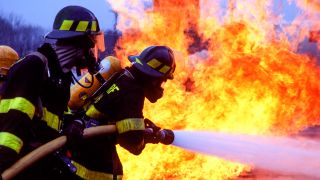How does water put out fire?
Water extinguishes fire, but it doesn't act on the flames themselves.

At a very young age, we're taught that water puts out fire. As children, we're told why this aspect of fire safety is so important, but we don't usually learn the science of how water subdues flames. So why does water put out fire? It might work differently than you think.
"Water puts out fire mainly because it's a really good heat sink," Sara McAllister, a fire combustion and behavior expert at the U.S. Forest Service's Missoula Fire Sciences Laboratory in Montana told Live Science. "It's really good at absorbing heat."
But you might be surprised that water doesn't act on the flames themselves. Fire requires three things to keep it going: fuel, oxygen and a heat source. Rather than fight the fire directly, the water acts on the fuel. Water actually makes it harder for the fuel — whether it's wood, brush or a building — to keep burning, Michael Gollner, a combustion expert at the University of California, Berkeley told Live Science.
Related: Why does wood catch fire, but metal doesn't?
When wood is burning, Gollner said, the heat of the fire is actually vaporizing substances in the wood, turning them to gas, which then fuels the fire. If you douse the wood in water, the fire must be hot enough to vaporize the water and the wood.
Because of water's high heat capacity, it takes a lot of energy or heat to vaporize water, Gollner said. If the flame spends its energy trying to vaporize the water, it has less energy to spend on heating the fuel. As the water absorbs the heat, the fuel is cooled. And if the flame can't heat up the fuel enough to vaporize it, the flame can't feed itself — so it will dissipate.
This is also a very effective way to contain a fire — wetting the potential fuel so the fire can't spread, Gollner added. This is the strategy behind sprinkler systems. They prevent the fire from spreading further, thus buying the firefighters time to get there.
Vaporized water is also a fire-extinguishing strategy for special scenarios, Gollner said. For example, consider a company's server room — pouring water on all those computers isn't ideal. So, in enclosed spaces, a different strategy is used to try and preserve equipment. With this approach, called water misting, droplets so small that they are like a vapor are misted into a room. "You can get so much water vapor in there that it displaces the oxygen and cools the flame," Gollner said.
Clearly, water is an effective extinguishing agent. But there are situations where water isn't a feasible strategy, particularly wildland fires, McAllister said. In these massive fires, "it's a lot harder to get [enough] water to where it's needed," she said.
Most often, the water you see dropped on wildfires isn't meant to put it out but rather to slow it down. Adding water can buy some time for other firefighting methods to work, "but it does not stop it," Gollner said. "There need to be people on the ground, physically removing the fuel and smothering it with dirt, but this is not something you can do when flames are 50 feet [15 meters] high."
Live Science newsletter
Stay up to date on the latest science news by signing up for our Essentials newsletter.
Donavyn Coffey is a Kentucky-based health and environment journalist reporting on healthcare, food systems and anything you can CRISPR. Her work has appeared in Scientific American, Wired UK, Popular Science and Youth Today, among others. Donavyn was a Fulbright Fellow to Denmark where she studied molecular nutrition and food policy. She holds a bachelor's degree in biotechnology from the University of Kentucky and master's degrees in food technology from Aarhus University and journalism from New York University.
Most Popular
By Lou Mudge